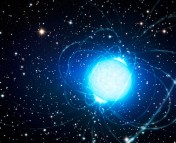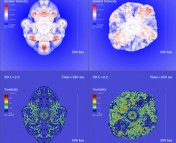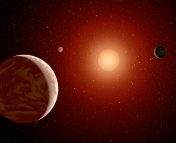
This guest post was written by Eda Vurgun. She is a Ph.D. student in the Astronomy and Space Sciences Department at Istanbul University. She is currently working on observational properties of neutron stars and X-ray binaries.
_______________________________________________
Title: Models for the Unusual Supernova iPTF14hls
Authors: S. E. Woosley
First Author’s Institution: Department of Astronomy and Astrophysics, University of California
Status: Published in ApJ [open access]
Astronomers recorded a supernova explosion in 1954. After many years, at the same location, iPTF14hls was discovered in September 2014 by intermediate Palomar Transient Factory (iPTF) and classified as a supernova event again. And yes, this is a bit confusing because supernova events happen once in a lifetime of a star. Long-term monitoring of the source revealed some bizarre and unique characteristics such as constant temperature and multiple outburst peaks which cannot be fully explained with the current understanding of typical supernovae.
iPTF14hls has hydrogen-dominated spectra. This type of spectrum is generally identified as a core-collapse supernova, but its characteristics also differ from known core-collapse supernovae. The light curve of iPTF14hls has five peaks and has remained bright for more than 600 days compared to the known supernova that usually show a single peak and descent of 100 days. In addition, the temperature of iPTF14hls remains constant instead of cooling. The total energy emitted in light during the first 600 days was about 2.2 × 10^50 ergs, making iPTF14hls a luminous, but not a particularly “superluminous” supernova. In a normal core-collapse supernova, the released energy is typically about 10^53 ergs. iPTF14hls requires larger energy to maintain the long duration.
In this study, there are several varieties of models to explain this unusual event. They are based upon circumstellar medium interaction in an ordinary supernova, pulsational supernovae, and magnetar formation. Each is able to explain the enduring emission and brightness of iPTF14hls, but has shortcomings when confronted with other observed characteristics.
Supernova issue

Figure 1: This is an image of SN1987a from the Hubble Space Telescope, taken 10 years after the explosion. Credit : Hubble Heritage Team (AURA/STScI/NASA)
Stars are formed in giant clouds of dust and gas and progress through their normal life as gas spheres heated by thermonuclear reactions in their cores. A supernova occurs at the end of a star’s life when they run out of fuel in its core. Depending on their mass, they reach the end of their evolution as a white dwarf, neutron star or black hole. If the star has the same mass as the Sun, it will turn into a white dwarf star (just like our Sun). The stars that have about 8 times the mass of our Sun usually undergo a supernova explosion. Depending on the mass, it may either collapse into a stable neutron star or a black hole. The underlying mechanism, the resulting supernova is also described as a core-collapse supernova.
Circumstellar Interaction
This unusual supernova event was very bright in the first 100 days and surprisingly has not cooled down yet even after 600 days. The surrounding circumstellar medium (CSM) which provide the initial conditions for the interaction plays a significant role in producing the total brightness. In the CSM interaction model, light is emitted as the outer layers of a supernova into a lower density medium. This luminous supernova can be powered by the CSM interaction of only about 1 solar mass of ejected-matter. The pile-up of the ejected-matter surrounds the supernova in a thin, dense shell. This shell moves with nearly uniform velocity and justifies the assumption of a single radius for the forward and reverse shocks.

Figure 2: Bolometric light curves as a function of time. The event is particularly bright during the first 100 days (From Fig. 1 in paper).
Pulsation
Pulsational supernovae occur in stars from 80 to 140 solar masses. Several possible scenarios for iPTF14hls have been proposed in this paper in order to explain the peculiarity of the source. In all cases, the hydrogen lines in the spectra are produced by a shock impacting the inner, slowly moving the edge of the ejected envelope. Models where the envelope was ejected many decades before, tend to be fainter.
According to the model, the pulsating continues over many decades and the actual death of the star occurs long after pulses have ceased. A star that remains at the site of iPTF14hls will continue shining for decades to centuries before the iron core finally collapses, possibly to a black hole of about 50 solar mass.

Figure 3: Light curve from the second and final pulse of example Model B120 (From Fig. 3 and 4 in the paper)
The pulsation model can be explained with two or three pulses. In the first pulse, the star ejects most of its envelope. At the second pulse, the rest of the envelope is ejected. The ejected mass from the second or third pulses collide with the first ejected matter. The event becomes brighter by this CSM interaction. And the remainder of matter finishes burning and collapses to a black hole. Some models say that iPTF14hls may have subsequent pulses running into that ejected envelope and into each other.

Figure 4: Velocity near peak emission in Model T115 (From Fig. 6 in the paper).
MAGNEticsTAR model
Magnetars are formed in the same way as all neutron stars, through the core-collapse of a massive star in a supernova explosion. They are extremely magnetic neutron stars with ultra-strong field strength >∼10^14 Gauss (which is a thousand trillion times stronger than the Earth’s) making them the most magnetic objects known. This magnetic field gives rise to very strong and characteristic bursts of X-rays and gamma rays. Magnetars are the central engine in a leading model for gamma-ray bursts. In this supernova case, magnetar may have deposited appreciable energy before the supernova was discovered.
Result? Lack of knowledge! Still.
The most likely explanations for iPTF14hls involve CSM interaction or magnetar birth. For CSM interaction, the event’s long duration is a consequence of the large radius (∼5 × 10^16 cm) of the CSM, and relatively mild speed of the supernova ejecta. Indeed, continuous emission lasting 600 days or more at 10^42 – 10^43 erg s−1, perhaps the defining characteristic of iPTF14hls, is easily achieved in a variety of models, including an ordinary supernova happening in a dense CSM medium.
One could envision relatively minor modifications to the circumstellar mass density, mass loss history, or supernova central engine that would give asymmetric models with the different velocities coming from ejecta at different angles. Conceptually, despite their uncertainties, these CSM models are the simplest explanation for iPTF14hls.
In pulsation theory, the mass that was ejected consists chiefly of hydrogen, helium, carbon, oxygen, nitrogen, neon and magnesium. Heavy elements like silicon, calcium, and iron are confined to what existed in the envelope of the star when it was born. No new iron or intermediate mass elements are ejected. In an ordinary supernova model, heavy elements would have been ejected including a solar mass or so of slowly moving oxygen. Freshly synthesized silicon, calcium, and iron might contribute to the spectrum.
In terms of all models, it is very hard to propose a satisfying explanation for this extraordinary mysterious supernova. The possible pre-explosive outburst in 1954 would also require an additional explanation, but perhaps most challenging is the lack of a clear explanation of how such a massive circumstellar shell came to be ejected just before the supernova.




